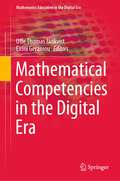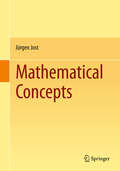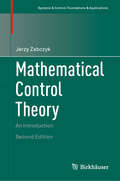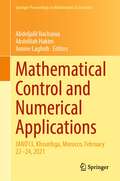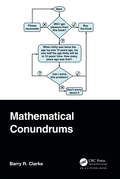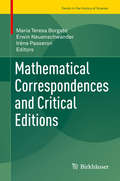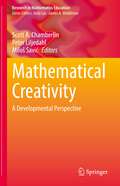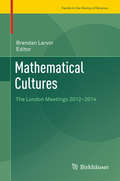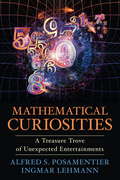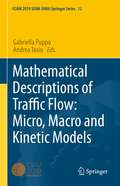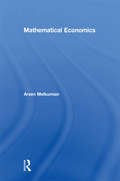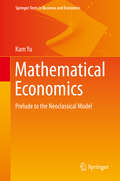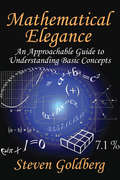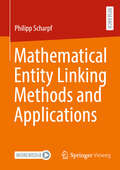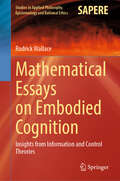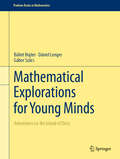- Table View
- List View
Mathematical Cognition and Understanding: Perspectives on Mathematical Minds in the Elementary and Middle School Years
by Katherine M. Robinson Donna Kotsopoulos Adam K. DubéThis book focuses on elementary and middle school children’s understanding of mathematics as well as the cognitive aspects involved in the development of mathematical knowledge, skills, and understanding. Children’s success in and understanding of mathematics stem from factors beyond the mathematics curriculum. Researchers are increasingly becoming aware of the necessity to consider a complex set of variables when accounting for large individual differences in mathematics achievement. These chapters contribute to how both researchers and educators can consider the multidimensionality of skills involved in developing mathematical knowledge in the middle school years as well as to how this knowledge can be used to enhance practices in the mathematics classroom. Topics include the cognitive and spatial skills involved in mathematics knowledge, the role of motivation in mathematics learning, the neurological processes and development of children’s mathematics skills, the development of understanding of arithmetic and fraction concepts, the factors relating to children’s word problem success, and techniques to promote mathematics understanding. This book and its companion, Mathematical Teaching and Learning, take an interdisciplinary perspective to mathematical learning and development in the elementary and middle school years. The authors and perspectives in this book draw from education, neuroscience, developmental psychology, and cognitive psychology. The book will be relevant to scholars/educators in the field of mathematics education and also those in childhood development and cognition. Each chapter also includes practical tips and implications for parents as well as for educators and researchers.
Mathematical Competencies in the Digital Era (Mathematics Education in the Digital Era #20)
by Uffe Thomas Jankvist Eirini GeraniouThis book focuses on the potential interplay between two distinct, yet related paradigm shifts in mathematics education, drawing on the notion of “networking of theories” through illustrative case studies from the Danish educational system and beyond. The first paradigm shift is the massive introduction of digital technology in the teaching and learning of the subject; the second is a shift from the traditional focusing on mastering of skills and knowledge to being concerned with the possession and development of mathematical competencies. This book builds on the Danish KOM (Competencies and the Learning of Mathematics) project, which sources its description of mathematical mastery primarily on the notion of a “mathematical competency” rather than on lists of topics, concepts, and results. This allows for an overarching framework, which captures the perspectives of mathematics teaching and learning at whichever educational level. While the KOM framework does not in detail address the role of digital technologies in relation to its description of different types of mathematical competencies, etc., the chapters of this book set out to do exactly this, while in the process also drawing on a selection of other theoretical constructs and frameworks from mathematics education research. Starting with introductory chapters by key researchers in the area, the book brings forth chapters for each of the KOM framework’s eight mathematical competencies, authored by Nordic researchers in combination with international scholars. The KOM framework also operates with three types of overview and judgement, which are specifically addressed in relation to the role of digital technologies in the third part of the book. The fourth and final part of the book broadens the scene and provides chapters of a more perspective nature in relation to mathematical competencies in the digital era. The book’s preface is by Susanne Prediger.
Mathematical Concepts
by Jürgen JostThe main intention of this book is to describe and develop the conceptual, structural and abstract thinking of mathematics. Specific mathematical structures are used to illustrate the conceptual approach; providing a deeper insight into mutual relationships and abstract common features. These ideas are carefully motivated, explained and illustrated by examples so that many of the more technical proofs can be omitted. The book can therefore be used: · simply as an overview of the panorama of mathematical structures and the relations between them, to be supplemented by more detailed texts whenever you want to acquire a working knowledge of some structure · by itself as a first introduction to abstract mathematics · together with existing textbooks, to put their results into a more general perspective · to gain a new and hopefully deeper perspective after having studied such textbooks Mathematical Concepts has a broader scope and is less detailed than standard mathematical textbooks so that the reader can readily grasp the essential concepts and ideas for individual needs. It will be suitable for advanced mathematicians, postgraduate students and for scientists from other fields with some background in formal reasoning.
Mathematical Connections: A Bridge to Algebra and Geometry
by Francis J. Gardella Patricia R. Fraze Joanne E. Meldon Marvin S. WeingardenMathematical Connections is a bridge that will take you from where you are in your study of mathematics to algebra and geometry. Since topics in mathematics are connected, this course will also lead you to data analysis and probability.
Mathematical Constants II (Encyclopedia of Mathematics and its Applications #169)
by Steven R. FinchFamous mathematical constants include the ratio of circular circumference to diameter, π = 3.14 …, and the natural logarithm base, e = 2.718 …. Students and professionals can often name a few others, but there are many more buried in the literature and awaiting discovery. How do such constants arise, and why are they important? Here the author renews the search he began in his book Mathematical Constants, adding another 133 essays that broaden the landscape. Topics include the minimality of soap film surfaces, prime numbers, elliptic curves and modular forms, Poisson–Voronoi tessellations, random triangles, Brownian motion, uncertainty inequalities, Prandtl–Blasius flow (from fluid dynamics), Lyapunov exponents, knots and tangles, continued fractions, Galton–Watson trees, electrical capacitance (from potential theory), Zermelo's navigation problem, and the optimal control of a pendulum. Unsolved problems appear virtually everywhere as well. This volume continues an outstanding scholarly attempt to bring together all significant mathematical constants in one place.
Mathematical Control Theory: An Introduction (Systems & Control: Foundations & Applications)
by Jerzy ZabczykThis textbook presents, in a mathematically precise manner, a unified introduction to deterministic control theory. With the exception of a few more advanced concepts required for the final part of the book, the presentation requires only a knowledge of basic facts from linear algebra, differential equations, and calculus.In addition to classical concepts and ideas, the author covers the stabilization of nonlinear systems using topological methods, realization theory for nonlinear systems, impulsive control and positive systems, the control of rigid bodies, the stabilization of infinite dimensional systems, and the solution of minimum energy problems.This second edition includes new chapters that introduce a variety of topics, such as controllability with vanishing energy, boundary control systems, and delayed systems. With additional proofs, theorems, results, and a substantially larger index, this new edition will be an invaluable resource for students and researchers of control theory.Mathematical Control Theory: An Introduction will be ideal for a beginning graduate course in mathematical control theory, or for self-study by professionals needing a complete picture of the mathematical theory that underlies the applications of control theory.From reviews of the first edition:At last! We did need an introductory textbook on control which can be read, understood, and enjoyed by anyone. Gian-Carlo Rota, The Bulletin of Mathematics BooksIt covers a remarkable number of topics...The exposition is excellent, and the book is a joy to read. A novel one-semester course covering both linear and nonlinear systems could be given...The book is an excellent one for introducing a mathematician to control theory. Bulletin of the AMSIndeed, for mathematicians who look for the basic ideas or a general picture about the main branches of control theory, I believe this book can provide an excellent bridge to this area. IEEE Control Systems Magazine
Mathematical Control and Numerical Applications: JANO13, Khouribga, Morocco, February 22–24, 2021 (Springer Proceedings in Mathematics & Statistics #372)
by Abdeljalil Nachaoui Abdelilah Hakim Amine LaghribThis book presents some sufficient mathematical content with expressive result. The aim of JANO13 is to bring together scientists to discuss their research in all the aspects of mathematics and their applications to different scientific discipline. The main topics of the conference is partial differential equations, mathematical control, numerical analysis and computer science. The conference is interested in recent developments on numerical analysis and real applications in computer science. The latter is viewed as a dynamic branch on the interface of mathematics and informatics that has been growing rapidly over the past several decades. However, its mathematical modelling and interpretation are still not well-explained and need much more clarifications. The main contributions of this book are to give some sufficient mathematical content with expressive results. As a growing field, it is gaining a lot of attention both in media and in the industry world, which will attract the interest of readers from different scientist disciplines.
Mathematical Conundrums (AK Peters/CRC Recreational Mathematics Series)
by Barry R. ClarkeWant to sharpen your mathematical wits? If so, then Mathematical Conundrums is for you. Daily Telegraph enigmatologist, Barry R. Clarke, presents over 120 fiendish problems that will test both your ingenuity and persistence. Between these covers are puzzles in geometry, arithmetic, and algebra (there is even a section for computer programmers). And, for the smartest readers who wish to stretch their mind to its limits, a selection of engaging logic and visual lateral puzzles is included. Although no puzzle requires a greater knowledge of mathematics than the high school curriculum, this collection will take you to the edge. But are you equal to the challenge? Features High-school level of mathematics is the only pre-requisite Variety of algebraic, route-drawing, and geometrical conundrums Hints section for the lateral puzzles Warm-up excercises to sharpen the wits Full solutions to every problem Barry R. Clarke has published over 1,500 puzzles in The Daily Telegraph and has contributed enigmas to New Scientist, The Sunday Times, Reader’s Digest, The Sunday Telegraph, and Prospect magazine. His book Challenging Logic Puzzles Mensa has sold over 100,000 copies. As well as a PhD in Shakespeare Studies, Barry has a master’s degree and academic publications in quantum physics. He is now working on a revised theory of the hydrogen atom. Other skills include mathematics tutor, filmmaker, comedy-sketch writer, cartoonist, computer programmer, and blues guitarist! For more information please visit http://barryispuzzled.com.
Mathematical Conversations: Multicolor Problems, Problems in the Theory of Numbers, and Random Walks
by E. B. Dynkin V. A. UspenskiiCombining three books into a single volume, this text comprises Multicolor Problems, dealing with several of the classical map-coloring problems; Problems in the Theory of Numbers, an elementary introduction to algebraic number theory; and Random Walks, addressing basic problems in probability theory.The book's primary aim is not so much to impart new information as to teach an active, creative attitude toward mathematics. The sole prerequisites are high-school algebra and (for Multicolor Problems) a familiarity with the methods of mathematical induction. The book is designed for the reader's active participation. The problems are carefully integrated into the text and should be solved in order. Although they are basic, they are by no means elementary. Some sequences of problems are geared toward the mastery of a new method, rather than a definitive result, and others are practice exercises, designed to introduce new concepts. Complete solutions appear at the end.
Mathematical Correspondences and Critical Editions (Trends in the History of Science)
by Maria Teresa Borgato Erwin Neuenschwander Irène PasseronMathematical correspondence offers a rich heritage for the history of mathematics and science, as well as cultural history and other areas. It naturally covers a vast range of topics, and not only of a scientific nature; it includes letters between mathematicians, but also between mathematicians and politicians, publishers, and men or women of culture. Wallis, Leibniz, the Bernoullis, D'Alembert, Condorcet, Lagrange, Gauss, Hermite, Betti, Cremona, Poincaré and van der Waerden are undoubtedly authors of great interest and their letters are valuable documents, but the correspondence of less well-known authors, too, can often make an equally important contribution to our understanding of developments in the history of science. Mathematical correspondences also play an important role in the editions of collected works, contributing to the reconstruction of scientific biographies, as well as the genesis of scientific ideas, and in the correct dating and interpretation of scientific writings. This volume is based on the symposium “Mathematical Correspondences and Critical Editions,” held at the 6th International Conference of the ESHS in Lisbon, Portugal in 2014. In the context of the more than fifteen major and minor editions of mathematical correspondences and collected works presented in detail, the volume discusses issues such as • History and prospects of past and ongoing edition projects, • Critical aspects of past editions, • The complementary role of printed and digital editions, • Integral and partial editions of correspondence, • Reproduction techniques for manuscripts, images and formulae, and the editorial challenges and opportunities presented by digital technology.
Mathematical Creativity and Mathematical Giftedness: Enhancing Creative Capacities In Mathematically Promising Students (ICME-13 Monographs)
by Florence Mihaela SingerThis book discusses the relationships between mathematical creativity and mathematical giftedness. It gathers the results of a literature review comprising all papers addressing mathematical creativity and giftedness presented at the International Congress on Mathematical Education (ICME) conferences since 2000. How can mathematical creativity contribute to children’s balanced development? What are the characteristics of mathematical giftedness in early ages? What about these characteristics at university level? What teaching strategies can enhance creative learning? How can young children’s mathematical promise be preserved and cultivated, preparing them for a variety of professions? These are some of the questions addressed by this book. The book offers, among others: analyses of substantial learning environments that promote creativity in mathematics lessons; discussions of a variety of strategies for posing and solving problems; investigations of students’ progress throughout their schooling; and examinations of technological tools and virtual resources meant to enhance learning with understanding. Multiple perspectives in the interdisciplinary fields of mathematical creativity and giftedness are developed to offer a springboard for further research. The theoretical and empirical studies included in the book offer a valuable resource for researchers, as well as for teachers of gifted students in specialized or inclusive settings, at various levels of education.
Mathematical Creativity: A Developmental Perspective (Research in Mathematics Education)
by Peter Liljedahl Miloš Savić Scott A. ChamberlinThis book is important and makes a unique contribution in the field of mathematics education and creativity. The book comprises the most recent research by renowned international experts and scholars, as well as a comprehensive up to date literature review. The developmental lens applied to the research presented makes it unique in the field. Also, this book provides a discussion of future directions for research to complement what is already known in the field of mathematical creativity. Finally, a critical discussion of the importance of the literature in relation to development of learners and accordingly pragmatic applications for educators is provided. Many books provide the former (2) foci, but omit the final discussion of the research in relation to developmental needs of learners in the domain of mathematics. Currently, educators are expected to implement best practices and illustrate how their adopted approaches are supported by research. The authors and editors of this book have invested significant effort in merging theory with practice to further this field and develop it for future generations of mathematics learners, teachers and researchers.
Mathematical Cultures
by Brendan LarvorThiscollection presents significant contributions from an international network project on mathematicalcultures, including essays from leading scholars in the history and philosophyof mathematics and mathematics education. Mathematicshas universal standards of validity. Nevertheless, there are local styles inmathematical research and teaching, and great variation in the place ofmathematics in the larger cultures that mathematical practitioners belong to. The reflections on mathematical cultures collected in this book are of interestto mathematicians, philosophers, historians, sociologists, cognitive scientistsand mathematics educators.
Mathematical Curiosities
by Alfred S. Posamentier Ingmar LehmannAn innovative and appealing way for the layperson to develop math skills--while actually enjoying itMost people agree that math is important, but few would say it's fun. This book will show you that the subject you learned to hate in high school can be as entertaining as a witty remark, as engrossing as the mystery novel you can't put down--in short, fun! As veteran math educators Posamentier and Lehmann demonstrate, when you realize that doing math can be enjoyable, you open a door into a world of unexpected insights while learning an important skill.The authors illustrate the point with many easily understandable examples. One of these is what mathematicians call the "Ruth-Aaron pair" (714 and 715), named after the respective career home runs of Babe Ruth and Hank Aaron. These two consecutive integers contain a host of interesting features, one of which is that their prime factors when added together have the same sum. The authors also explore the unusual aspects of such numbers as 11 and 18, which have intriguing properties usually overlooked by standard math curriculums. And to make you a better all-around problem solver, a variety of problems is presented that appear simple but have surprisingly clever solutions.If math has frustrated you over the years, this delightful approach will teach you many things you thought were beyond your reach, while conveying the key message that math can and should be anything but boring.
Mathematical Descriptions of Traffic Flow: Micro, Macro and Kinetic Models (SEMA SIMAI Springer Series #12)
by Andrea Tosin Gabriella PuppoThe book originates from the mini-symposium "Mathematical descriptions of traffic flow: micro, macro and kinetic models" organised by the editors within the ICIAM 2019 Congress held in Valencia, Spain, in July 2019. The book is composed of five chapters, which address new research lines in the mathematical modelling of vehicular traffic, at the cutting edge of contemporary research, including traffic automation by means of autonomous vehicles. The contributions span the three most representative scales of mathematical modelling: the microscopic scale of particles, the mesoscopic scale of statistical kinetic description and the macroscopic scale of partial differential equations.The work is addressed to researchers in the field.
Mathematical Descriptors of Molecules and Biomolecules: Applications in Chemistry, Drug Design, Chemical Toxicology, and Computational Biology (Synthesis Lectures on Mathematics & Statistics)
by Subhash C. BasakThis book provides an up-to-date overview of data driven and evidence-based empirical approaches in the efficient application of chemodescriptors and biodescriptors. Currently there is a steady increase in the use of data analytics and model-based decision support systems in basic and applied research in chemoinformatics, bioinformatics, pharmaceutical drug design, predictive toxicology, and computational biology. Since there are a plethora of modeling methods and a large number of chemodescriptors and biodescriptors available today, robust statistical and machine learning methods are applied throughout. In addition, the development of statistically robust predictive models in rank deficient cases using chemodescrip tors and biodescriptors is discussed. Readers are provided with an up-to-date overview of the theoretical background, calculation methods, and proper use of chemodescriptors and biodescriptors in model building, with special emphasis on computer-assisted organic synthesis, new drug discovery, hazard assessment of chemicals, and computational biology of emerging global pathogens. The book also discusses the applications of alignment-free sequence descriptors (AFSDs) in vaccine design and the characterization of emerging global pathogens such as the Zika virus and SARS-CoV-2. The utility of molecular fragment-based descriptors in building useful quantitative structure-activity relationship (Q)SAR) models is detailed as is the use of mathematical structural descriptors in chemical synthesis planning.
Mathematical Economics
by Arsen MelkumianThis textbook, designed for a single semester course, begins with basic set theory, and moves briskly through fundamental, exponential, and logarithmic functions. Limits and derivatives finish the preparation for economic applications, which are introduced in chapters on univariate functions, matrix algebra, and the constrained and unconstrained optimization of univariate and multivariate functions. The text finishes with chapters on integrals, the mathematics of finance, complex numbers, and differential and difference equations. Rich in targeted examples and explanations, Mathematical Economics offers the utility of a handbook and the thorough treatment of a text. While the typical economics text is written for two semester applications, this text is focused on the essentials. Instructors and students are given the concepts in conjunction with specific examples and their solutions.
Mathematical Economics: Prelude to the Neoclassical Model (Springer Texts in Business and Economics)
by Kam YuThis textbook provides a one-semester introduction to mathematical economics for first year graduate and senior undergraduate students. Intended to fill the gap between typical liberal arts curriculum and the rigorous mathematical modeling of graduate study in economics, this text provides a concise introduction to the mathematics needed for core microeconomics, macroeconomics, and econometrics courses. Chapters 1 through 5 builds students’ skills in formal proof, axiomatic treatment of linear algebra, and elementary vector differentiation. Chapters 6 and 7 present the basic tools needed for microeconomic analysis. Chapter 8 provides a quick introduction to (or review of) probability theory. Chapter 9 introduces dynamic modeling, applicable in advanced macroeconomics courses. The materials assume prerequisites in undergraduate calculus and linear algebra. Each chapter includes in-text exercises and a solutions manual, making this text ideal for self-study.
Mathematical Elegance: An Approachable Guide to Understanding Basic Concepts
by Steven GoldbergThe heart of mathematics is its elegance; the way it all fits together. Unfortunately, its beauty often eludes the vast majority of people who are intimidated by fear of the difficulty of numbers. Mathematical Elegance remedies this. Using hundreds of examples, the author presents a view of the mathematical landscape that is both accessible and fascinating. At a time of concern that American youth are bored by math, there is renewed interest in improving math skills. Mathematical Elegance stimulates students, along with those already experienced in the discipline, to explore some of the unexpected pleasures of quantitative thinking. Invoking mathematical proofs famous for their simplicity and brainteasers that are fun and illuminating, the author leaves readers feeling exuberant-as well as convinced that their IQs have been raised by ten points. A host of anecdotes about well-known mathematicians humanize and provide new insights into their lofty subjects. Recalling such classic works as Lewis Carroll's Introduction to Logic and A Mathematician Reads the Newspaper by John Allen Paulos, Mathematical Elegance will energize and delight a wide audience, ranging from intellectually curious students to the enthusiastic general reader.
Mathematical Encounters and Pedagogical Detours: Stories of Disturbance and Learning Opportunities in Teacher Education
by Rina Zazkis Boris KoichuThis book explores the idea that mathematics educators and teachers are also problem solvers and learners, and as such they constantly experience mathematical and pedagogical disturbances. Accordingly, many original tasks and learning activities are results of personal mathematical and pedagogical disturbances of their designers, who then transpose these disturbances into learning opportunities for their students. This learning-transposition process is a cornerstone of mathematics teacher education as a lived, developing enterprise. Mathematical Encounters and Pedagogical Detours unfold the process and illustrate it by various examples. The book engages readers in original tasks, shares the results of task implementation and describes how these results inform the development of new tasks, which often intertwine mathematics and pedagogy. Most importantly, the book includes a dialogue between the authors based on the stories of their own learning, which triggers continuous exploration of learning opportunities for their students.
Mathematical Engineering of Deep Learning (Chapman & Hall/CRC Data Science Series)
by Benoit Liquet Yoni Nazarathy Sarat MokaMathematical Engineering of Deep Learning provides a complete and concise overview of deep learning using the language of mathematics. The book provides a self-contained background on machine learning and optimization algorithms and progresses through the key ideas of deep learning. These ideas and architectures include deep neural networks, convolutional models, recurrent models, long/short-term memory, the attention mechanism, transformers, variational auto-encoders, diffusion models, generative adversarial networks, reinforcement learning, and graph neural networks. Concepts are presented using simple mathematical equations together with a concise description of relevant tricks of the trade. The content is the foundation for state-of-the-art artificial intelligence applications, involving images, sound, large language models, and other domains. The focus is on the basic mathematical description of algorithms and methods and does not require computer programming. The presentation is also agnostic to neuroscientific relationships, historical perspectives, and theoretical research. The benefit of such a concise approach is that a mathematically equipped reader can quickly grasp the essence of deep learning.Key Features: A perfect summary of deep learning not tied to any computer language, or computational framework. An ideal handbook of deep learning for readers that feel comfortable with mathematical notation. An up-to-date description of the most influential deep learning ideas that have made an impact on vision, sound, natural language understanding, and scientific domains. The exposition is not tied to the historical development of the field or to neuroscience, allowing the reader to quickly grasp the essentials. Deep learning is easily described through the language of mathematics at a level accessible to many professionals. Readers from fields such as engineering, statistics, physics, pure mathematics, econometrics, operations research, quantitative management, quantitative biology, applied machine learning, or applied deep learning will quickly gain insights into the key mathematical engineering components of the field.
Mathematical Entity Linking Methods and Applications
by Philipp ScharpfThis research book explores the adaptation of traditional Entity Linking techniques to Mathematical Entity Linking (MathEL) for STEM disciplines, addressing the limitations of current Information Retrieval methods in handling mathematical expressions. By developing and evaluating novel MathEL approaches using AI, Machine Learning, and the Wikidata Knowledge Graph, significant progress is achieved in areas such as Formula Concept recognition, semantic formula search, mathematical question answering, physics exam question generation, and STEM document classification. The study also introduces a suite of open-source Wikimedia MathEL tools, including AnnoMathTeX, MathQA, and PhysWikiQuiz, designed to advance Mathematical Information Retrieval and support innovative applications in academic and educational contexts.
Mathematical Essays on Embodied Cognition: Insights from Information and Control Theories (Studies in Applied Philosophy, Epistemology and Rational Ethics #72)
by Rodrick WallaceThis book provides a unique formal foundation for the development of statistical tools useful in the exploration of observational and experimental data related to embodied cognition. The asymptotic limit theorems of information and control theories can be used to construct statistical tools analogous to -- but different from -- regression models for the study of the often highly punctuated cognitive phenomena embedded in and hence influenced by a surrounding ecosystem of which the phenomena are themselves part. The book builds probability models based on those theorems that incorporate embodiment at a number of scales and levels of organization, ranging from the effects of stress on the immune system within a higher organism, through institutional (and machine) cognition under challenge from adversaries, to the failure of public health institutions under pathogen challenge. In distinct contrast to the existing literature, many detailed, worked-out examples provide templates for sophisticated readers to build their own model/tool constructs.
Mathematical Explorations
by Alan F. BeardonMathematical Explorations follows on from the author's previous book, Creative Mathematics, in the same series, and gives the reader experience in working on problems requiring a little more mathematical maturity. The author's main aim is to show that problems are often solved by using mathematics that is not obviously connected to the problem, and readers are encouraged to consider as wide a variety of mathematical ideas as possible. In each case, the emphasis is placed on the important underlying ideas rather than on the solutions for their own sake. To enhance understanding of how mathematical research is conducted, each problem has been chosen not for its mathematical importance, but because it provides a good illustration of how arguments can be developed. While the reader does not require a deep mathematical background to tackle these problems, they will find their mathematical understanding is enriched by attempting to solve them.
Mathematical Explorations for Young Minds: Adventures on the Island of Oxisz (Problem Books in Mathematics)
by Gábor Szűcs Bálint Hujter Dániel LengerThis book presents a carefully curated selection of mathematical problems suitable for young minds aged 12 and beyond. Most of these problems have been adapted from the Dürer Competition, a venerable mathematics competition in Hungary renowned for fostering teamwork and encouraging creative thinking in the realm of mathematical problem-solving. Within the pages of this book, readers are invited to accompany Albrecht, Tarkal, and Zsordi on 14 captivating journeys to the enigmatic Island of Oxisz, where they will encounter a total of 84 thought-provoking problems. Some of these challenges are intricately interconnected, elevating the level of difficulty. The concluding section provides comprehensive solutions and helpful hints, illuminating the paths taken by the three friends to tackle the problems. No specialized prior knowledge is required beyond a solid foundation in mathematics from the first seven years of school. Nevertheless, many problems in the book demand original ideas or clever combinations of elementary principles. This book offers students, mathematics educators, and trainers alike a captivating glimpse into a distinctive competition, making it a valuable resource for cultivating problem-solving skills at an early age.

